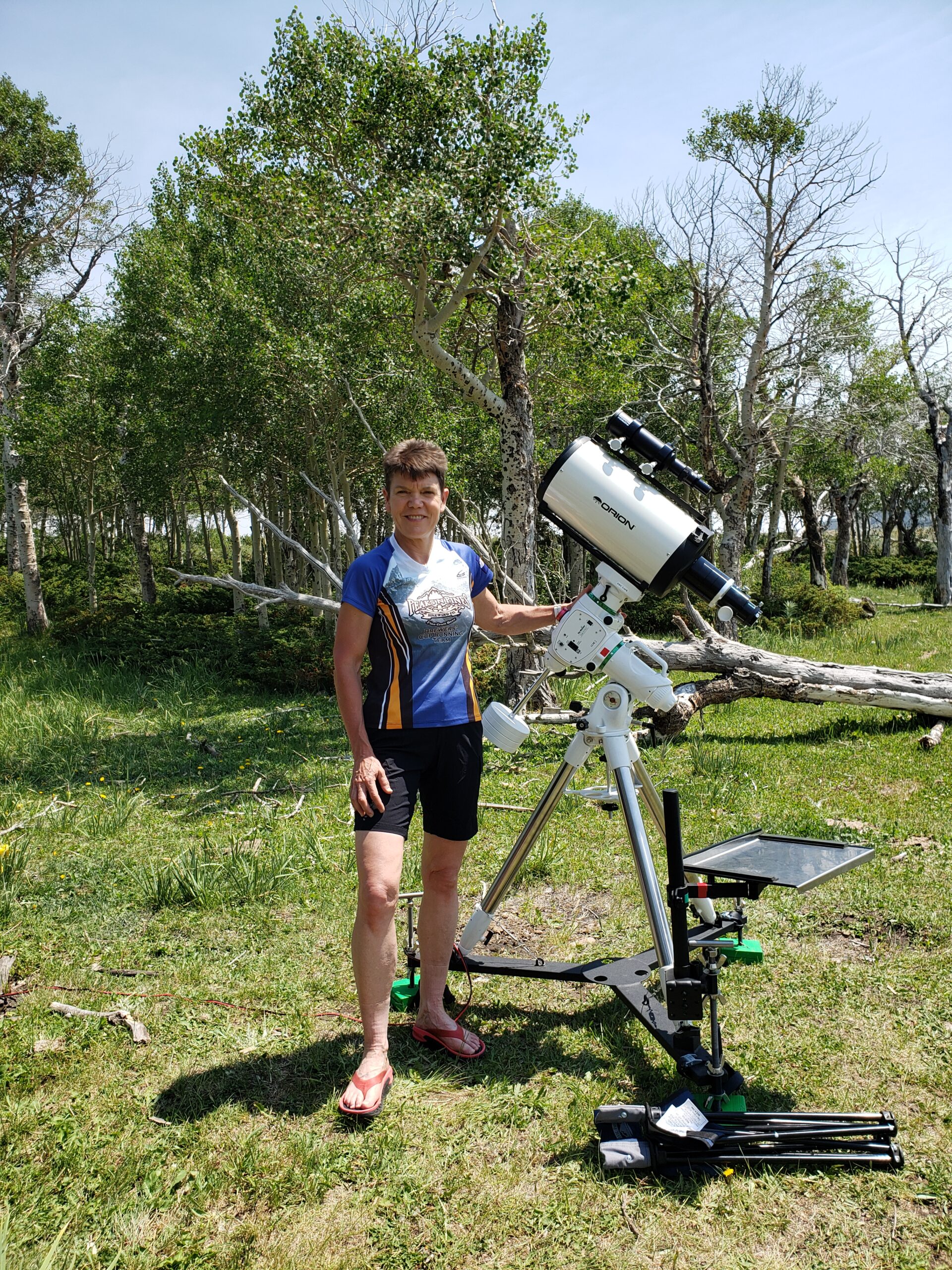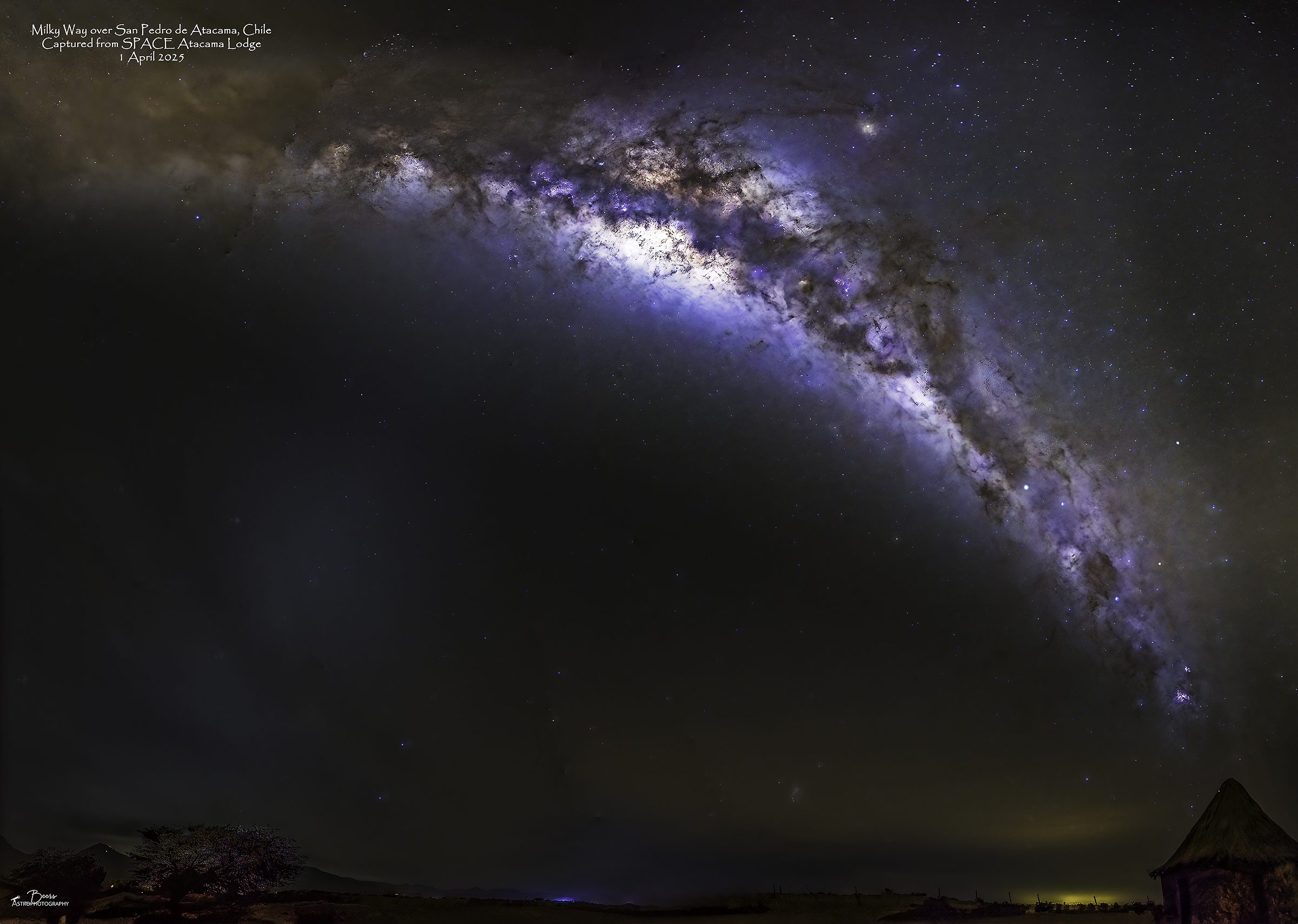Just like most things in my life, this astrophotography passion was planted as seemingly random seeds, then grew and blossomed from my husband’s unwavering support. Paul has encouraged and enabled this passion, as well as all the others that we’ve been through in our 35 year marriage. Paul’s idea of spending our 30th wedding anniversary, not in Sicily where it all began, but in Grand Island, Nebraska started the journey…photographing the total solar eclipse, in totality over Grand Island on the exact time we got married in 1987. Truly a romantic and memorable way to celebrate our special together day. Then, Paul’s idea of getting a camper to spend time together dispersed camping in the dark sky regions of Colorado, New Mexico, Wyoming, and Utah stepped the journey to its next level. At first, we filled the nights on those camping trips photographing the Milky Way. Finally, for Christmas 2020, Paul really upped the game…getting me a telescope, equatorial mount and many other peripherals (too numerous to mention!) enabling my completely falling in love with the pursuit of capturing the wonders of the universe. I never would have imagined I would have become so passionate – but I’ve found deep space astrophotography to be the perfect mix of science and art to challenge both sides of this engineer’s brain for the long run.

Life so far…
Suzanne Beers was born in Delaware, spending her early childhood moving every few years throughout the east and Midwest (Delaware, Pennsylvania, Michigan, Ohio) as her father progressed through his career as a Chrysler Corporation engineer, settling with her mother in Columbus, Ohio for junior high and high school.
Suzanne has a plethora of degrees, giving her plenty of cheering flexibility during college football season – Miami University (BS, Physics), Ohio State University (BS, Mechanical Engineering), New Mexico Highlands University (MBA), New Mexico State University (MS, Electrical Engineering) and Georgia Tech (PhD, Electrical Engineering).
She served in the US Air Force as an engineer, missileer, operational tester, satellite control system sustainer, and commander in assignments (moving less than she did as a child) in New Mexico, Sicily, Georgia, Colorado, and a very short time (thankfully) in Washington D.C. Upon retirement, she joined the MITRE Corporation in Colorado Springs, Colorado where she leads a department providing test, evaluation and systems engineering expertise to the Department of Defense.
Throughout Suzanne’s adult life, she’s progressed approximately each decade to a more expensive hobby! The 1980’s were settling into life as an Air Force officer, meeting (across the classroom in the NMHU MBA program) and marrying Paul; moving to Sicily to get an “operational skill” in Ground Launched Cruise Missiles – best assignment of all! The 1990’s were back in Albuquerque, New Mexico (with a brief stint in Atlanta) ballooning with Pat Swanson (the instigator of the DSO AP interest). The 2000’s was a move to Colorado Springs and taking up shotgun shooting – skeet, trap, and sporting clays. 2010 was the decade of triathlon – lured into it by a good AF friend living in St Croix, USVI saying “you’re pretty good at all three of those things, you should come down here and do our little race (Ironman 70.3)” – that race was my first in 2011 and my last in December 2019! Then she was further sucked into triathlon – full Ironman distance – when convinced by another friend (over beer) that doing a full Ironman would be “fun.” The 2020’s appear to be the decade (and hopefully beyond to a lifetime) in the pursuit of the passion of astrophotography.
I couldn’t have done it without…
Those who inspired and mentored me…
My husband, Paul A. Baye – As I mentioned above, Paul has supported me in every way from the time we met across the MBA classroom in 1984 throughout our lives together. This “latest” passion is no exception…he started this journey with the solar eclipse adventure, reinvigorated it with the Beast, and took it to the next level with Big Bertha. Along the way, he has researched and purchased, designed and built, and updated and installed everything I’ve needed (or thought I needed) to enable the images you see on these pages. I most definitely could not have done it without his love, support, and patience.
Pat Swanson – Our friend and ballooning partner – the pilot and owner of Burning Desire II – in Albuquerque, who casually mentioned she was getting into astrophotography. My initial reaction was “that’s interesting, there’s no way I could do that!” That off-hand comment motivated me to step all-into this hobby.
Craig Wennersten – I met Craig when I signed up for Mike’s Camera’s Milky Way workshop that he led in Westcliffe, Colorado in July 2019. At that point, he became my one-and-only “real life” (as opposed to YouTube) mentor. Shortly after I got Big Bertha and was struggling to figure her out, he came to the house (driving up from Sierra Vista, AZ!!) to give me a private lesson. During that time on the front patio, he helped me achieve first light and launched me headlong into gaining the skills I needed to make this all happen!
Ann Chavtur – I discovered the Colorado Springs Astronomy Club while researching how to clean the mirrors of my Ritchey-Chretien (R-C) telescope. The CSASTRO President, Tom DeClue, was so friendly that I joined the club. My first astrophotography group meeting included members sharing their work. Ann showed several of her images, including a couple of spectacular Milky Way arches. Her name sounded familiar, but I couldn’t place it… I reached out to her for information on how she captured her images – after a couple of conversations, she mentioned our common background – we both work/worked for the MITRE Corporation at its Colorado Springs site. Since then, we’ve had a running dialogue on processing, target databases, capture settings – I’ve learned so much and really enjoyed having an astrophotography colleague to celebrate and commiserate with.
YouTube – Except the one lesson from Craig, I’ve learned everything I know from YouTube! There’s a wealth of information ripe for the learning (what else are you going to do while you’re riding your spin bike during COVID but watch YouTube videos and take copious notes??). I’m sure I’ll leave someone off this list, but I owe a debt of gratitude and education to: Trevor Jones (AstroBackyard), Alyn Wallace (WITNS), Aaron Vaillant (AV Astronomy), Tim Richter (AstroAddict), Helena Cochrane (Helena’s Astrophotography), Ruzeen Farsad (Astro Farsography), Antoine & Dalia Grelin (Galactic Hunter), Nico Carver (Nebula Photos), Brenda Petrella (Outdoor Photography School) and Rafael Pons (PhotoPills).
Astrophotography SW and website developers – An extra special hats off to those who develop the tools of this trade. They provide incredibly powerful tools and share their engineering prowess for little or no compensation. Those that I use for planning, execution, and processing include…Astrophotography Tool (APT), Sequence Generator Pro (SGP), Astro Pixel Processor (APP), Deep Sky Stacker (DSS), PHD Guiding (PHD2), PoleMaster, ASCOM drivers; and Stellarium, Telescopius, PhotoPills, Clear Outside, Astropheric.
If that wasn’t enough…
Southern Hemisphere skies are award-winning!!
I’ve commented before, dark skies really make a big difference. When I shared the images I captured during my trips to Chile’s Atacama desert, I marveled at their clear, dark, skies (6 of them in a row – during both year’s trips!) I’m very proud to say that my Milky Way image from this year’s trip was recognized by the Astronomical League’s Williamina Fleming Imaging Award and my Fighting Dragons of Ara from last year’s trip (also recognized by the Astronomical League) was selected as Photo of the Month by the Webb Deep Sky Society!
Continue Reading Southern Hemisphere skies are award-winning!!
2nd Annual Most Amazing Astrophotography trip to the Atacama Desert!
After last year’s most amazing trip to the San Pedro de Atacama Celestial Explorations (SPACE) Atacama Lodge where I spent six nights imaging under their glorious dark and clear skies, I vowed to make the trip an annual event. This year’s traveling companions, Jan Elliott and Dave Parks, shared the adventure with me. The one-line summary is: my travel was completely FUBAR, but once I finally arrived the skies did not disappoint! …and yes, there will be a 3rd Annual!!
Continue Reading 2nd Annual Most Amazing Astrophotography trip to the Atacama Desert!


